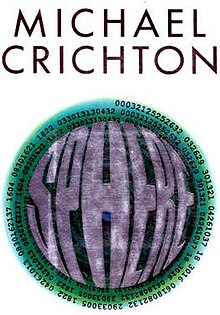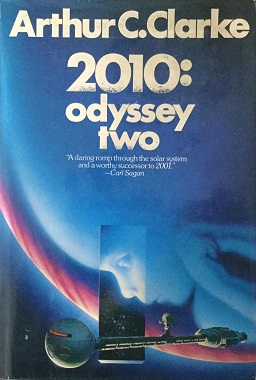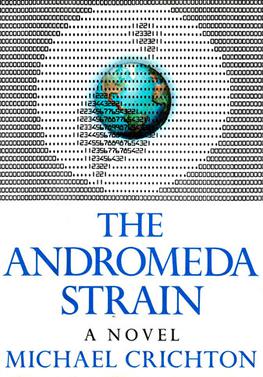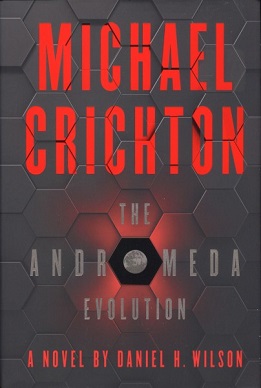Plot summary
A group of scientists (namely psychologist Norman Johnson, mathematician Harry Adams, zoologist Beth Halpern, astrophysicist Ted Fielding, and marine biologist Arthur Levine), along with U.S. Navy personnel, travel to a deep sea habitat at the bottom of the Pacific Ocean, where an enormous spacecraft has been discovered.
During the descent, Levine becomes claustrophobic and is returned to the surface. The other scientists arrive safely at Habitat DH-8. After their arrival and subsequent pressurization to the habitat's exotic-gas environment, the Navy sends a robot to enter the spacecraft first, which locates and opens a panel near the spacecraft door.
As the robot's cameras focus on the opened panel, labels in English indicate the spacecraft is actually a U.S. spacecraft constructed in the future and sent through time, appearing on the seabed at least 350 years before its creation. The robot is unable to open a hatch leading further inside, forcing the team to don pressure suits and explore the spacecraft. In a large cargo hold, the team discovers a mysterious spherical object that is clearly of extra-terrestrial origin.
Reasoning the ship's future builders were apparently unaware that it had already been found in their past, Adams becomes convinced that the team will not survive to report their discovery. Remaining behind after the rest of the team returns to the habitat, Adams succeeds in opening and entering the sphere. Meanwhile, on the surface, a Pacific cyclone forces the supporting Naval ships to evacuate, trapping and isolating the scientists on the ocean floor for five days. Adams is found and returned to the DH-8 Habitat where he awakens with a terrible headache and little-to-no memory of how he opened the sphere or what occurred while he was inside. Immediately afterwards, the team is contacted by an intelligent, seemingly friendly alien entity that calls itself "Jerry".
At first, Jerry communicates with the scientists using a numeric code transmitted to the habitat's computer. While the team struggles to communicate with Jerry, increasingly bizarre and deadly events occur, including the appearance of impossible sea creatures that Halpern claims cannot exist (such as shrimp with no digestive organs), confirmed when Jerry informs them he is "manifesting" the creatures.
At this point, members of the team start to die in various attacks by giant squid, and the dwindling band of survivors struggle in their dealings with the unthinkably powerful, childlike, and temperamental alien entity. Johnson realizes he must use psychology to keep the remaining survivors (Johnson, Adams, and Halpern) alive.
After re-translating the original code, Johnson realizes by transposition the entity's name is "Harry". Johnson hypothesizes that the sphere is an object which allows a person's subconscious thoughts to manifest in reality, and Harry Adams has acquired the power through entering it. This is confirmed by his childhood fear of squid, especially the giant squid in the novel Twenty Thousand Leagues Under the Seas , manifested in the form of a vast number of small squid and later a giant squid that attacks the DH-8 Habitat.
Johnson and Halpern sedate Adams and wait for contact to be re-established with the surface, but the manifestations continue. Halpern accuses Johnson of having entered the sphere and gaining access to the power. While unable to recall this incident, Johnson comes close to yielding, until he watches a security video of Halpern entering the sphere herself. Rejecting the notion, Halpern decides that Johnson is an imminent threat and defends herself by planting potent explosives around the spacecraft and habitat, and then attempts to suffocate Johnson by manipulating the habitat's life-support system.
Escaping from the habitat, Johnson goes to the spacecraft and enters the presence of the sphere, then the sphere itself. Inside the sphere, he finds a large sea of translucent "foam," and has a conversation in his thoughts with some sort of entity that speaks in cryptic riddles, who eventually tells Johnson that the greatest power humans possess is the ability to imagine things. After leaving the sphere, Johnson decides to escape using the submarine docked at Habitat DH-7, a nearby habitat for Navy personnel, but cannot abandon the other survivors. Now empowered in the same way as Adams and Halpern, Johnson returns to DH-8, and using the submarine, the trio escape before the explosives set by Halpern count down and destroy the spaceship, research habitat, and surrounding site.
On the surface, confined to a decompression chamber, the trio ponder on what version of their story to tell the Navy. Realizing they could not control the power granted them by the sphere, they decide its knowledge to be too dangerous to be communicated, and resolve to use its power to remove it from themselves and alter their memories, replacing the fantastical experiences with more mundane memories of a technical failure, though it is hinted that Halpern did not do the same.


















